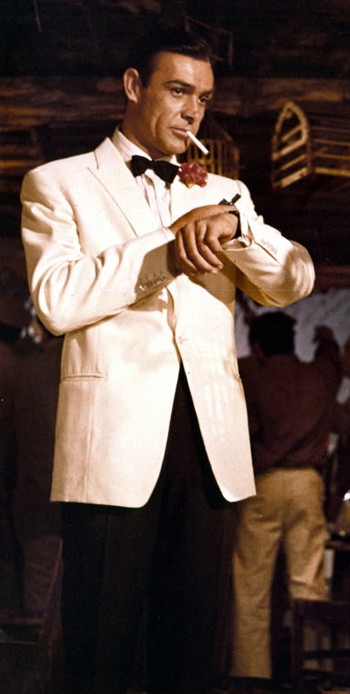Goldfinger (1964) is the third film in the James Bond series and also the third to star Sean Connery as the fictional MI6 agent James Bond. It is based on the novel of the same name by Ian Fleming.
The film also stars Honor Blackman as Bond girl Pussy Galore and Gert Fröbe as the title character Auric Goldfinger, along with Shirley Eaton as famous Bond girl Jill Masterson.
The film's plot has Bond investigating gold smuggling by gold magnate Auric Goldfinger and eventually uncovering Goldfinger's plans to attack the United States Bullion Depository at Fort Knox. Goldfinger was the first Bond blockbuster, with a budget equal to that of the two preceding films combined. Principal photography took place from January to July 1964 in the United Kingdom, Switzerland and the American states of Kentucky and Florida.
The release of the film led to a number of promotional licensed tie-in items, including a toy Aston Martin DB5 car from Corgi Toys which became the biggest selling toy of 1964. The promotion also included an image of gold-painted Shirley Eaton as Jill Masterson on the cover of Life.
The release of the film led to a number of promotional licensed tie-in items, including a toy Aston Martin DB5 car from Corgi Toys which became the biggest selling toy of 1964. The promotion also included an image of gold-painted Shirley Eaton as Jill Masterson on the cover of Life.
Many of the elements introduced in the film appeared in many of the later James Bond films, such as the extensive use of technology and "gadgets" by Bond and an extensive pre-credits sequence that was not a major part of the main storyline. Goldfinger was the first Bond film to win an Academy Award and opened to largely favourable critical reception.
The film was a financial success, recouping its budget in just two weeks and is hailed as the series' quintessential episode, still being acclaimed as one of the best films in the entire Bond canon.
Goldfinger had a large impact on the rest of the Bond series as its script came to be seen as a template for all other Bond films to follow.
It was the first of the series showing Bond relying heavily on technology as well as the first to show a pre-credits sequence with only a tangential link to the main story—in this case allowing Bond to get to Miami after a mission. Also introduced for the first of many appearances is the briefing in Q-branch, allowing the viewer to see the gadgets in development.
The subsequent films in the Bond series follow most of Goldfinger's basic structure, featuring a henchman with a particular characteristic, a Bond girl who is killed by the villain, big emphasis on the gadgets and a more tongue-in-cheek approach, though trying to balance action and comedy.
Goldfinger has been described as perhaps "the most highly and consistently praised Bond picture of them all" and after Goldfinger, Bond "became a true phenomenon.
Indeed it has been said that Goldfinger was the cause of the boom in espionage films in the 1960s, so much so that in "1966, moviegoers were offered no less than 22 examples of secret agent entertainment, including several blatant attempts to begin competing series, with James Coburn starring as Derek Flint in the film Our Man Flint and Dean Martin miscast as Matt Helm".
Even within the Bond canon, Goldfinger is acknowledged; the 22nd Bond film, Quantum of Solace, includes an homage to the gold body paint death scene by having a female character dead on a bed nude, covered in crude oil.



























No comments:
Post a Comment